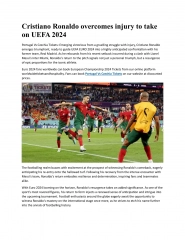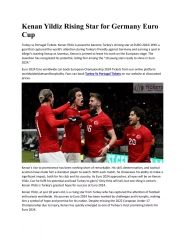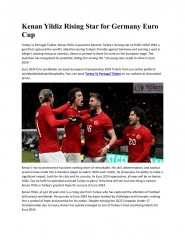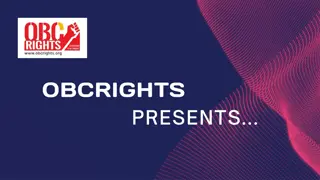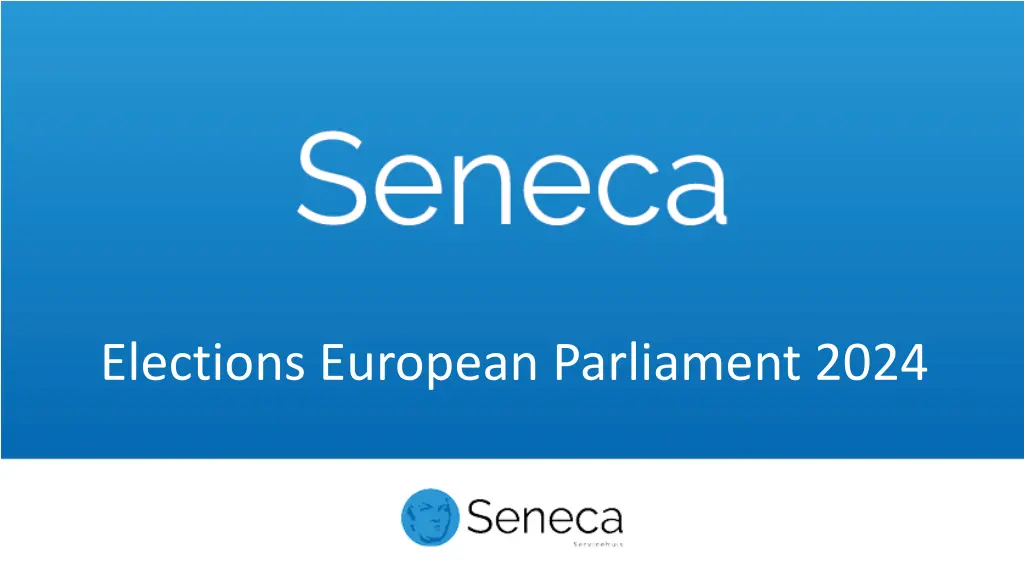
Understanding the European Union: History, Elections, and Impact
Explore the history, elections, and influence of the European Union (EU), from its origins post-WWII to its expansion and key goals. Learn about the functioning of the EU, European Parliament elections, and how the EU affects daily life.
Download Presentation

Please find below an Image/Link to download the presentation.
The content on the website is provided AS IS for your information and personal use only. It may not be sold, licensed, or shared on other websites without obtaining consent from the author. If you encounter any issues during the download, it is possible that the publisher has removed the file from their server.
You are allowed to download the files provided on this website for personal or commercial use, subject to the condition that they are used lawfully. All files are the property of their respective owners.
The content on the website is provided AS IS for your information and personal use only. It may not be sold, licensed, or shared on other websites without obtaining consent from the author.
E N D
Presentation Transcript
Outline lessons Lesson 1: History and functioning of the EU. Lesson 2: Elections European Parliament. Lesson 3: After the elections.
Opzet lessenserie Les 1: Geschiedenis en werking van de Europese Unie Les 2: Verkiezingen Europees Parlement Les 3: Na de verkiezingen
Lesson 1 History and functioning of the EU
Influence of the EU on your life What is the European Union? How does the EU influence your life?
History of the European Union Ideal following WWII: 'Preventing war through cooperation in Europe'. Goals: Revitalize the economy. Maintain peace. The forerunner of the EU: European Coal and Steel Community (ECSC) Countries: Netherlands, Belgium, Germany, France, Italy, and Luxembourg. After World War II: tensions between France and Germany. Objective: preventing possible wars by not having individual steel industries per country. Success of the ECSC: reduction of tensions between countries.
History of the European Union Expansion of cooperation in various areas. Key change: Opening up the borders between the six countries. Benefits: No additional taxation for businesses in cross-border sales, reduction of time and money due to decreased border controls. Consequence: Enormous economic growth, increase in membership applications. Challenges of free trade: Competition between companies from different countries, need for harmonised rules. Harmonisation of rules: European countries increasingly align rules, creating common European laws
History of the European Union Formation of the European Union in 1992 with four key freedoms: Free movement of people, goods, services, and capital. Democratic determination of common rules within the EU. Ambitions of the EU at the beginning of the twenty-first century: Own constitution, core values such as freedom, equality, and human dignity, objectives such as environmental protection, promotion of technological progress.
Key Concepts Sovereignty: The possession of the highest authority in a territory. Supranational: 'above nation' and involves countries giving up a portion of their sovereignty to a higher authority. Intergovernmental organisation: An organisation in which countries cooperate without transferring power to a higher body.
Soevereiniteitsdilemma The EU is increasingly legislating on an expanding range of topics. Issue: Erosion of a country's sovereignty. However: EU member states achieve more by collaborating within the EU. Sovereignty dilemma: Should countries cooperate with each other and give up some of their sovereignty, or should they retain complete control over their laws and refrain from cooperation? Different opinions: Internationalists: More cooperation between countries. Laws should be more internationally determined. Nationalists: Laws and regulations should be made by the states again.
Europese Invloed Supranational Partly supranational, partly intergovernmental The EU and the member states may only make laws together. Member states may only make laws that are in line with previous European legislation. Agriculture, Environment, Consumer protection Transportation, Area of freedom, security and justice Intergovernmental EU member states cooperate with each other on a supranational basis. The EU may only support, coordinate, or complement national policies. The EU is the sole institution authorized to make laws in this field. The EU can determine many things, but not everything The Treaty of Lisbon (2007) specifies the areas in which the EU has supranational powers and those in which it does not. Public health Culture Tourism Education Defense Monetary policy, Fisheries policy, Making international agreements
Activity: Anti-EU and pro-EU: How big are these parties? What about Dutch political parties? How do you find out and how popular are they? Come up with 3 criteria to determine the extent to which a party is anti-EU or pro-EU. Provide a brief explanation for your choice. Create a scale where you place 10 self-selected Dutch political parties next to each other, from most anti-EU to most pro-EU. Use your criteria. Compare your scale with another student and discuss the placement of the different parties. What similarities and differences are there between your scales? Place yourself on your own line: which party would you vote for based on the criteria? Then, assess the popularity of the anti-EU and pro-EU parties and make a prediction based on this about whether the Dutch government will want more or less European integration in the long term.
Activity: European Union Diamond Task Which topics do you find cooperation most desirable and least desirable? Examine the list of sixteen topics below. Which topic do you find important, and which do you not? Place it in the EU diamond. op section: most important for EU regulation. Row below: 2 topics you find next most important, and so on downwards. Bottom: topic that you do not think should be regulated at the European level, but rather at the national level. Compare your diamond with classmates. Safety and the rule of law Climate action and environment International cooperation (outside of the EU) Space exploration Tourism Defence/European Army Education Employment and social affairs Energy Health Transportation and traveling/transport Constitutional rights Food and farming Safety on the Internet Consumer Protection Migration and asylum
Institutions of the European Union The EU, like the Netherlands, has various political actors. You can categorise the governance according to the separation of powers: Legislative power European Parliament (First and Second Chamber NL) Executive power European Commission Judicial power European Court of Justice (Government and civil servants) Council of the European Union (ministers) European Council
Institutions of the European Union European Commission: the executive body of the EU with 27 Commissioners, one from each member state. They are responsible for the overall functioning of the EU and not of the member state they come from. Tasks include monitoring whether member states apply legislation and proposing legislation. They have the sole right of initiative in the European Union. European Council: This consists of all the heads of government of the member states. They determine the political direction of the EU but otherwise play no role in European legislation. Council of the European Union (Council of Ministers): This is where the sectoral ministers of the governments of the member states sit. Composition changes depending on the legislation being discussed. For example, when it comes to Agriculture and Fisheries, all Agriculture ministers from the member states attend the Council of Ministers to discuss matters together. Court of Justice of the EU (CJEU): Consists of 27 judges, one per member state. They adjudicate when EU member states fail to comply with EU laws and regulations. They also ensure that EU legislation and treaties are applied uniformly across the member states.
Activity: EU institutions in the news Indicate which institutions the source refers to and specify whether it concerns a legislative, executive or judicial institution. The European Union remains concerned about the independence of judges and media in Poland and Hungary. A country that is a member of the European Union must be a rule of law state and adhere to the principles of a rule of law. Poland and Hungary pay little attention to these principles. Therefore, they are closely monitored monitoredby the [European Council/European Commission] Council/European Commission], which is a [legislative/executive/judicial institution] [legislative/executive/judicial institution] The Common Agricultural Plan (CAP) is the EU's way of providing farmers with additional income support. Janusz Wojciechowski, the European Commissioner for Agriculture, advocates for an increase in the CAP. However, this Commissioner does not determine this unilaterally. The budget must be approved by the [European Parliament/European Court of Justice] [European Parliament/European Court of Justice] which is a [legislative/executive/judicial institution] [legislative/executive/judicial institution] "It's time to build a sovereign Europe. Let's not decide the future of Europe in Moscow or anywhere else but on European soil. Let's be builders. Let's get to work building policies on sovereignty, European defense, and technological sovereignty. [European This statement is about European policu for the future. This was said by [European Parliament/European Council]. Parliament/European Council]. This is about which task? Legislative/Executive/Judicial Legislative/Executive/Judicial [European In a notable ruling, the [European Court of Justice/Council of the [European Court of Justice/Council of the European Union] European Union]held that an employer is obliged to provide or reimburse glasses for screen workers with vision problems. This case was brought by a Romanian man who had questions about the directive on visual display units. The judgment was that glasses fall within the directive and employers can be required to purchase glasses. This concerns a [legislative/executive/judicial institution] institution] [legislative/executive/judicial
Activity: Create an EU quiz Create your own EU pub quiz! Different categories: European institutions, history and member states, open questions Create a quiz and come up with three questions for each category. In total, you will have a quiz of twelve questions. Don't forget to write down the answers for yourself and for the questions you have devised. Play the quiz in class to conclude this lesson. Have fun!
Lesson 2 Elections European Parliament
History of the European Parliament 1952: Assembly of the European Coal and Steel Community. Objective: To provide a forum for representatives of the member states to discuss issues related to coal and steel, To promote economic cooperation, To contribute to the formation of a common European policy in the field of coal and steel.
History of the European Parliament 1958: First meeting of the European Parliamentary Assembly. Objective: Representation of the peoples of member states. Members elected from national parliaments. 1979: First direct elections of the European Parliament. Initially, the European Parliament did not have much power. Through various treaties, including Maastricht (1992), Amsterdam (1997), and Lisbon (2007), the European Parliament has gained more powers. Brexit referendum (2016): UK voted to leave the EU. 2021: UK exited the EU. Distribution of seats in the European Parliament.
Organisation of the European Parliament Currently, there are 705 members of the European Parliament, representing the 27 member states. After the elections, the number of members will increase to 720. The number of seats a country receives depends on its population size. The minimum is 6 seats (for Luxembourg, Cyprus, and Malta). The maximum is 96 seats (for Germany). Netherlands currently has 29 seats, but this will increase to 31 after the elections.
Role and functions of the European Parliament The European Parliament represents the citizens of the EU. It has legislative, oversight, and budgetary responsibilities: Together with the Council of the European Union, it holds legislative power. It can accept, amend, or reject laws proposed by the European Commission. It does not have the right of initiative and cannot compel the Commission to create specific policies. It oversees the European Commission. It approves the annual budget, along with the Council of the European Union. The European Parliament must consent to treaties between the EU and other countries before they come into force. It has the right to conduct inquiries into matters within its jurisdiction. It has the right to receive and address petitions from EU citizens.
European Parliament Elections Every 5 years, elections are held for the European Parliament. The elections are conducted based on the principle of Proportional Representation. All EU citizens aged 18 and older are eligible to vote for the parties participating from their own country. For example, an Italian living in the Netherlands can vote for an Italian party in the Netherlands. Most countries, like the Netherlands, have party lists on which voters can cast their votes. After the elections, political parties in the European Parliament form political groups based on ideological agreements.
Political Groups/Fractions in the EP At least 23 members At least 7 EU countries Membership in a group is not compulsory Currently 7 groups Advantages of a political group Important role in setting the agenda, more speaking time, more office space, etc.
The 7 current groups Bron: De zeven fracties van het Europees Parlement | Onderwerpen | Europees Parlement (europa.eu)
Activity: Party Profile European Parliament Elections Work in groups of 2-3 students and delve into the research on 2 political parties: 1 Dutch party and 1 foreign party participating in the EP elections. Answer the following questions: Who is the lead candidate? Who are the candidates for this party? What are their main party positions? Think about various topics such as climate, refugees, etc. What values are important for this party when looking at its positions? Where does this party stand on the left-right spectrum in its own country? Was the party previously a member of a group within the European Parliament? If so, which one? Based on which ideology was the group formed? Where does the group stand on the left-right spectrum in the European Parliament? Each group will present their findings to the class. If you are not presenting: Which party appeals to you? You do not have to share this information.
Activity: Which party would you vote for? Hold a free and secret election in the class. There will be no class discussion about who voted for what
Voter turnout Voter Turnout EP Election 2019: 50.66% (EU) / 41.97% (NL) Second Chamber (NL) Election 2023: 77.7% EP Election 2024: Why? Article NOS (2019) "Out of touch": Lack of understanding of the role of the EP. Distrust towards EU politics. Concerns about interference in national affairs. Worries about the costs of the EU. Feeling of powerlessness among citizens: 'My vote won't make a difference'
Activity: Civic Participation How can we increase voter turnout? Brainstorm in groups of 4
Lesson 3 After the elections
Results elections Results Netherlands
Results election Result Europe
After the election Political Groups in the European Parliament Groups formed based on ideological agreements. Currently: 7 groups. Each group elects a chair and a board. Responsible for leading the group and setting the political agenda. Regular meetings to discuss positions and make decisions. Groups can collaborate and form coalitions based on common interests.
Activity: Debate! Solution for engaging citizens with the European Union: History education in the European Union should be a shared curriculum
Activity: Viewing assignment Zondag met Lubach Arjen Lubach While watching, answer the questions on the handout




